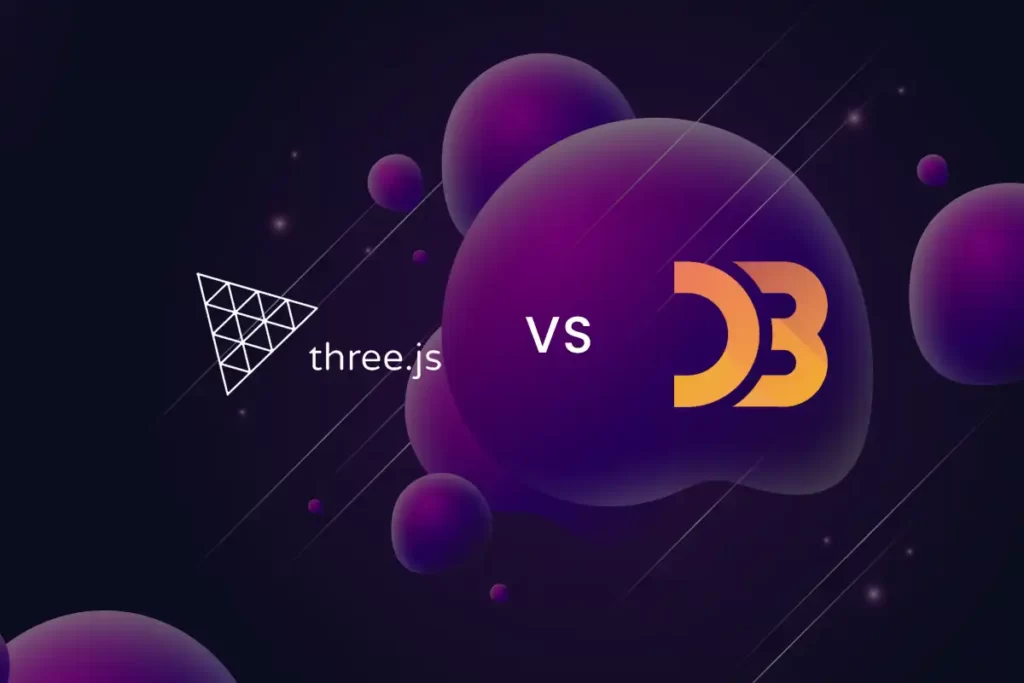
In web development, visualization tools like three js and d3 js are essential to bringing data to life. Whether you’re aiming for a detailed 3D map, a force-directed graph, or simply looking to represent data through a bar chart or line chart, choosing the proper library can make all the difference. While three.js excels in 3D graph visualization and globe representation, d3.js dominates grid-based and data visualization techniques. OpenLayers may give you the foundation, but for dynamic, responsive visuals, the debate often narrows down to these two powerhouses. Let’s check their detailed key features comparison.
Key Features Comparison
Three.js
WebGL integration
Three.js stands out prominently when it comes to integrating WebGL. For those unfamiliar, WebGL stands as a JavaScript API enabling the rendering of 3D graphics directly in compatible browsers, eliminating the need for plugins. With three.js, the complexities of WebGL are abstracted, making it easier to create impressive 3D graphics. Whether you’re developing a texture-rich 3D model or initiating a scroll-triggered animation for your JS projects, three.js provides a robust foundation.
3D model rendering capabilities
When the conversation shifts to 3D model rendering, three.js is undeniably a frontrunner. Providing a wide range of tools makes sure that your 3D graphics are crisp, interactive, and captivating. For developers familiar with Python or Java, integrating these 3D models into larger projects becomes relatively seamless. Whether you’re creating a game character, architectural representation, or any other 3D model, three.js has got you covered.
Camera controls and animations
One of the cornerstones of a captivating 3D visualization is how the viewer interacts with it. With three.js, camera controls are smooth and intuitive. Developers possess the flexibility to tailor how the camera moves and zooms, thereby enriching the overall user experience. Incorporate its robust animation capabilities, and you’ll have a library that transforms your visualizations into a truly immersive experience.
D3.js
Data Binding
D3.js, which stands for ‘Data-Driven Documents,’ excels in data binding. It connects data to your document, enabling transformations based on the provided data. This concept may seem reminiscent of those familiar with React or React JS. With d3.js, every piece of data can be associated with a specific element, be it a bar in a bar chart or a node in a network diagram.
SVG manipulation
In the realm of 2D graphics and diagram representations, SVG (Scalable Vector Graphics) stands tall. D3.js is adept at manipulating these SVG elements, enabling developers to craft detailed and responsive diagrams. Whether you’re looking to plot a line chart, network graph visualization, or any other data visualization, d3.js offers the tools to make it interactive and engaging.
Dynamic data visualization tools
When the data updates, visuals should too. With d3.js, dynamic data visualization isn’t just possible. It’s straightforward. Indeed, it offers a set of tools that smoothly adapt to new data. For instance, if you’re working with live data feeds or frequently updated JavaScript datasets, d3.js ensures your visuals stay relevant and up-to-date, whether rendered in Python or standalone web apps.
Pros and Cons
Pros of Three.js
Engaging 3D Visuals
With the growing trends of artificial intelligence and machine learning visualizations, three.js has become an essential tool for rendering complex 3D models.
Versatility with JS Frameworks
Whether you’re working with Vue JS, Next JS, or React JS, three.js seamlessly integrates, allowing developers to harness its 3D capabilities.
Gaming Capabilities
The library’s compatibility with game engines means that budding game developers or those wanting a gamified front-end experience can use it well.
Wide Support and Community
The three.js community is vast, with many JS developers sharing resources, which can be a boon for anyone starting or troubleshooting a project.
Cons of Three.js
Learning Curve
There’s a steep learning curve for those new to 3D graphics, especially when compared to libraries like Babylon JS or ChartJS.
Performance Issues
High-end visuals sometimes come at the cost of performance, especially in resource-constrained environments.
Not Ideal for 2D
While it can handle 2D, more efficient libraries like Google Charts or d3 charts exist for such tasks.
Pros of D3.js
Dynamic Data Representation
For projects that involve real-time data visualization, such as machine learning predictions or graph visualization, d3.js is exceptional.
Flexibility with Data Formats
From CSVs in Python applications to JSON in NodeJS setups, d3.js can handle a variety of data formats.
Integration with JS Libraries
Whether you’re using NextJS, React JS, or Node JS, integrating d3.js for data visualization is straightforward.
Customizable Graphics
Unlike out-of-the-box solutions like ChartJS, d3.js allows for high customizability, ensuring visuals align with brand guidelines.
Cons of D3.js
Complexity for Beginners
The library offers a lot, but newcomers might find it overwhelming, especially those transitioning from simpler tools like Google Charts.
Performance Overhead
While powerful, handling vast datasets can sometimes lead to performance lags.
Requires Proficient JS Knowledge
A decent understanding of JavaScript is crucial to harness its full potential. This might be a hurdle for those who are new or come from a non-JS developer background.
Both libraries offer unique strengths, and understanding their pros and cons is crucial for making an informed choice based on the project’s requirements.
Conclusion
Navigating the world of JavaScript libraries can be tricky, especially when comparing two giants like three.js and d3.js. Think of it this way: if your project revolves around diving deep into 3D visuals, like games or interactive models, then three.js might be your go-to. But if you’re aiming to tell a compelling story with your data using charts, graphs, or infographics, d3.js has got your back. Each has its unique strengths that cater to different project needs. So, take a moment, ponder your project’s goals, and then pick the toolkit that resonates best with those ambitions.
Unlock the future with ThreejsDevelopers company! Dive into a world where expert three.js developers craft cutting-edge digital marvels. Elevate your projects; let innovation lead the way. Your next breakthrough awaits.


